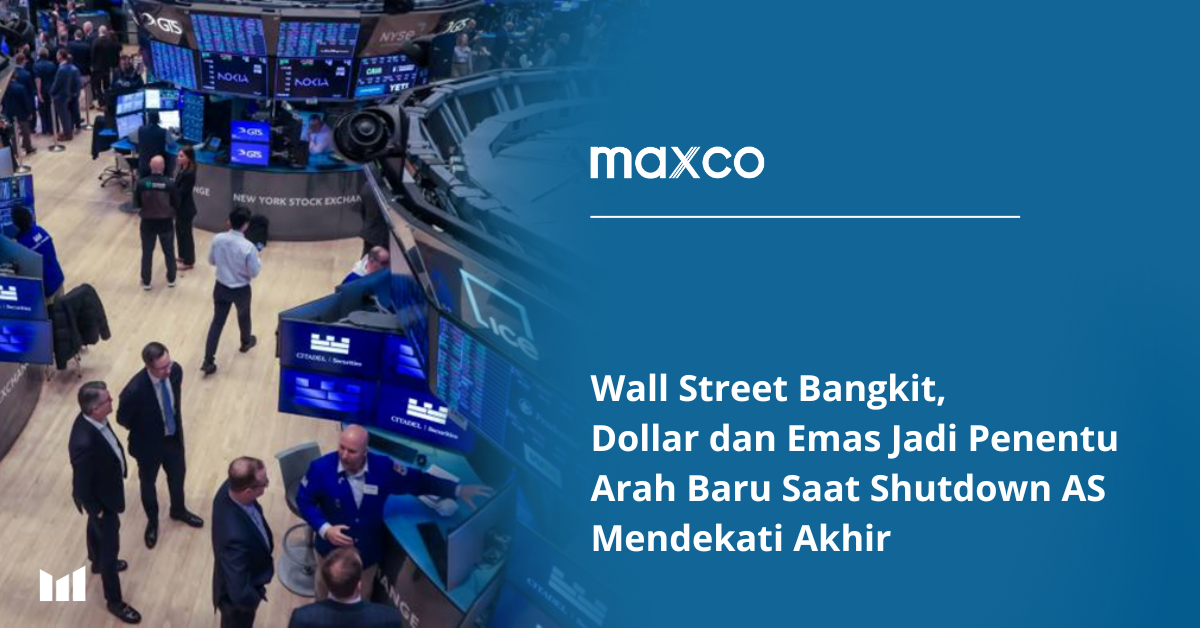Wall Street kicked off the week with a strong rally, fueled by signs of political progress in Washington that increased the likelihood of ending the longest government shutdown in U.S. history. But behind the surge in equities, global investors are shifting their focus to the next major market drivers: the Federal Reserve’s monetary policy outlook and the direction of the U.S. dollar.
The S&P 500 jumped 1.5%, while the Nasdaq Composite led the advance with a 2.3% surge, powered by a rebound in major technology stocks after several weeks of selling pressure. Chipmakers such as Nvidia and AMD were among the top movers, while the Dow Jones Industrial Average posted a more modest gain of under 1%.
Market optimism strengthened after the U.S. Senate passed a key procedural vote that paves the way for a temporary funding bill to keep the government open until January 2026. This development raised hopes that the political deadlock in Congress will soon end, allowing the release of official economic data that has been delayed for weeks.
“Investors are celebrating the removal of a major political risk — but now they’re turning to the next question: what does this mean for inflation, the dollar, and the Fed’s policy direction?” said a macro analyst at Wells Fargo.
Dollar and Bonds: Shift Toward Risk Assets
The U.S. Dollar Index (DXY) initially dipped before reversing to close 0.2% higher in New York, as safe-haven demand eased and Treasury yields climbed. The 10-year U.S. Treasury yield pushed back up to 4.45%, reflecting expectations that capital will rotate out of Treasuries and into riskier equities.
However, some investors caution that if the reopening of government leads to economic data that comes in weaker than expected — particularly labor market and inflation reports — the dollar could quickly lose momentum.
Gold and Risk Sentiment
Spot gold prices stabilized around $4,130 per ounce after a slight decline during the Asian session. Safe-haven demand has softened, but the medium-term outlook for gold remains bullish if post-shutdown data confirms a slowdown in the U.S. economy that could prompt the Federal Reserve to accelerate interest rate cuts.
We expect volatility to return as markets shift back to trading based on economic growth indicators that were largely ignored during the shutdown.
The Senate’s progress quickly echoed across global markets:
- Nikkei 225 in Japan rose 1.3%, supported by continued yen weakness after PM Sanae Takaichi signaled a more flexible fiscal stance.
- Euro Stoxx 600 climbed 1.1%, while London’s FTSE 100 touched an all-time record high, boosted by positive sentiment and a weaker British pound.
This cross-continental rally highlights the resurgence of global risk appetite after weeks of cautious positioning driven by fiscal uncertainty and a lack of U.S. macro guidance.
From Politics to Data
With the shutdown crisis nearing its end, markets now shift their attention to two key areas:
• Delayed economic data — inflation, unemployment, and retail sales reports will set the tone for the Fed’s next rate decisions.
• Central bank communication — any dovish signals may extend the equity rally and pressure the dollar.
“Market euphoria may prove temporary. Once official data returns, attention will shift back to economic reality,” said the head of global strategy at Morgan Stanley.
Markets welcome the political progress with relief, but the next direction will be driven by the incoming data. With the dollar losing momentum and gold holding at elevated levels, global investors appear poised for a new phase in which the U.S. “soft landing” narrative is tested again by post-shutdown macro realities.
Maxco Futures views the upcoming data releases as a crucial moment long awaited by the market, which has been trading based on incomplete and sentiment-driven assumptions during the shutdown.
Ade Yunus, ST, WPA
Global Market Strategies
